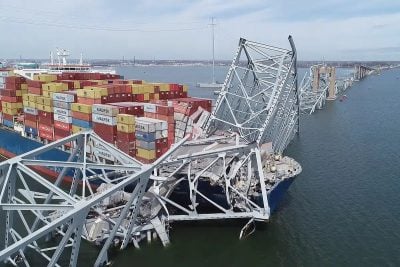Baltimore’s Frances Scott Key Bridge Disaster Declared a “Crime Scene”

All Global Research articles can be read in 51 languages by activating the Translate Website button below the author’s name (only available in desktop version).
To receive Global Research’s Daily Newsletter (selected articles), click here.
Click the share button above to email/forward this article to your friends and colleagues. Follow us on Instagram and Twitter and subscribe to our Telegram Channel. Feel free to repost and share widely Global Research articles.
Global Research Referral Drive: Our Readers Are Our Lifeline
***
There has been no public announcement of why the huge and fully loaded cargo ship Dali lost power in the early morning hours of March 26, 2024, before drifting into a support pylon of Baltimore’s Frances Scott Key Bridge and causing it to collapse into the Patapsco River in the economically worst US infrastructure disaster of the 21st century.
But an early report from the Vessel Tracker website declared:
“…enquiries into the cause of the ship’s failure to navigate safely have commenced. The accident site was being treated as a crime scene.” (emphasis added)
So far, no public authority has made any statements on possible criminal aspects of the incident.
The “crime scene” declaration may simply reflect the fact that when an accident involves loss of life, possible criminal charges must be addressed.
In the Dali disaster, six workmen engaged in highway repairs on the bridge’s roadway are missing and presumed dead. Who is ultimately responsible?
Is a criminal investigation routine, or do authorities suspect findings of criminality due to negligence, failure to follow prescribed procedures in maneuvering the ship, or in preparing it to depart the Baltimore port fully loaded? The question also remains of whether the ship was under cyberattack, as some have speculated, but which officials vehemently deny.
Vessel Tracker also now states that,
“The crew of the Dali will remain on board the vessel until the investigation into the accident has been completed. Representatives from Grace Ocean Private and Synergy Marine, the Singapore-flagged ship’s owner and managing company respectively, reported that all crew members were actively engaged in their standard duties and are assisting the National Transportation Safety Board (NTSB) and Coast Guard with the ongoing investigation.”
Some say, however, that the investigation may not be easily completed. An informant with military seagoing experience writes,
“The operations in this accident are unknown and will not be examined, certainly not in the media, until the lawyers and insurance clerks dig into the sequence. Any comments now are conjecture. May take years to sort the operations out.”
So will the crew of the Dali “remain on board the vessel” for years? Somehow I doubt it. At some point they will be released to go home, probably without charges. The criminality, if any, would likely reach much higher into the ship’s ownership. But any damages would likely become a matter of civil jurisdiction, not a criminal matter. That’s how these things work.
Already the ship’s owners are trying to limit their liability. Vessel Tracker reports:
“The owner of the ship, the Singapore-based Grace Ocean Private L The company can be forced to pay for the disaster at $43 million and filed a ‘limitation of liability’ action in federal court on April 1, invoking a little-known statute used in maritime law.
The complaint asks a federal judge to consolidate claims against the company in U.S. District Court in Maryland and to either find the company not liable at all or to cap its liability at $43 million, which the company claims is the value of the ship and its freight.”
What then will be the outcome?
What we all can agree on is that Baltimore is a small, crowded harbor where these immense cargo ships with dubious mechanical systems, complex computer arrays, small foreign crews with unknown creds, and insufficient tugboat accompaniment, have to perform complex maneuvers to reach open water.
And if you look at the satellite photos, the space between the bridge pylons was not that large. Yet the harbor is authorized to accommodate cargo ships twice Dali’s size.
Video
click lower right corner for full screen
Like the 1985 space shuttle Challenger disaster, which I experienced at NASA, the Dali crash was therefore on the order of “an accident waiting to happen.” A security and risk expert with whom I consulted confirms that somewhere in Baltimore there is a documented risk mitigation system with such a crash buried in it such that there had to have been people on the scene who were not surprised., “From my understanding,” the expert said, “The possibility of something like this was captured in a risk assessment, but not every risk treatment is possible.”
What else do we know?
Evidently as Dali moved along the channel under the bridge there were two ship blackouts, not just one as initially reported.
There are also reports that two-minutes of audio on the ship’s recorders have not been released. And why were there total power blackouts, not just an engine stopping and having to restart?
We may never know.
My point for now is that it’s enough to realize that given modern safety systems, “failure scenarios” exist for every major piece of commercial or industrial machinery in existence.
The problem therefore becomes risk “mitigation,” along with what you are willing to pay for it. This involves an assessment of what the consequences could be of a failure and what are you willing to shell out for prevention.
The risk assessment system had to be aware and had to have documented that if a ship of Dali’s size hit a pylon, it was probably “lights out” for the entire bridge structure. For those in the know, and there have to be such people, the incident would not have been a “surprise.”
One major source of risk mitigation being met by Baltimore’s harbor authorities was to have one or more experienced local pilots on-board to advise the ship’s Master on reaching and staying in the channel between the bridge’s pylons, thereby allowing it to safely reach the open waters of the Chesapeake Bay. Reportedly, Dali had two such local pilots.
But there was a second possible source of risk mitigation available; namely tugboats.
Reportedly, when the Dali left its port berth on the Dundalk side of the harbor, two tugs moved alongside it to assure safe guidance. We don’t yet know when the tugs fell away, leaving the ship to execute a complex maneuver to turn and head downriver. We do know, however, that Dali’s crew did request a tug rescue with its Mayday call. For that it was too late.
But why didn’t the harbor tugs stay with the Dali as it got ready to navigate the relatively narrow passage between the bridge’s pylons? My expert consultant speaks again: “It would be financially impossible to have a tug fleet large enough to bumper every ship going in and out.”
One factor leading to this impossibility may have been what a larger tugboat fleet would have done to Baltimore’s competitiveness vis-à-vis other ports. And since in our capitalist financial system, every extra cost affects the bottom line and therefore determines owners’ profits, corners are always cut.
Still, somewhere along the way, those in charge should have done a calculation that estimated the probabilities of a catastrophic system failure arrayed against the costs of mitigating it with more tugs or tighter regulations.
This calculation would properly have assessed the human and economic consequences of a bridge failure; for instance, what we are now facing with a temporary harbor shutdown and suspension of thousands of jobs, along with five to seven years to rebuild a major transportation artery that’s a conduit for massive amounts of hazardous materials and other commodities along the East Coast corridor.
Then, seeing a shutdown as unacceptable, an outside funding source such as the US Department of Transportation might have stepped up to pay for the extra tugs or other costs. Now, President Joe Biden says the federal government will pay the entire cost of a rebuild, possibly $2 billion. That’s called hindsight; maybe his offer comes a little late.
My forecast is that in the end, no individual will be charged, the owners will get off with a damage assessment that is a drop in the bucket compared to the economic loss, and that the capitalists who profit from the system will assure that gigantic cargo ships with risky safety features will continue to operate in US harbors like Baltimore that were built for an earlier age.
Meanwhile, the taxpayer will foot the bill for mishaps, with costs even higher if municipalities like Baltimore have to borrow money in the capital markets. Or the federal government can tack it onto its already out-of-control deficit.
It seems that in the end, the risk mitigation strategy for the Francis Scott Key Bridge was simply, as my wife told me, “Just keep your fingers crossed.”
Working at NASA, when I watched the space shuttle Challenger blow up on January 28, 1986, that was NASA’s risk mitigation strategy too.
*
Note to readers: Please click the share button above. Follow us on Instagram and Twitter and subscribe to our Telegram Channel. Feel free to repost and share widely Global Research articles.
This article was originally published on VT Foreign Policy.
Richard C. Cook is a co-founder and Lead Investigator for the American Geopolitical Institute. Mr. Cook is a retired U.S. federal analyst with extensive experience across various government agencies, including the U.S. Civil Service Commission, FDA, the Carter White House, NASA, and the U.S. Treasury.
He is a regular contributor to Global Research.
Featured image is from the Public Domain
 Our Country, Then and Now
Our Country, Then and Now
by Richard C. Cook
ISBN: 9781949762853
E-book ISBN: 978-1-949762-86-0
Year: 2023
Our Country Then and Now takes us on a 400-year journey through America’s history, providing unique snapshots from African enslavement, native dispossession, financial scandals, and wars of expansion and aggression, interspersed with tales from author Richard C. Cook’s ancestry—from Puritan forebears to fighters in the American Revolutionary War and the Civil War, to Midwest Pioneer farmers and their relations with native nations.

